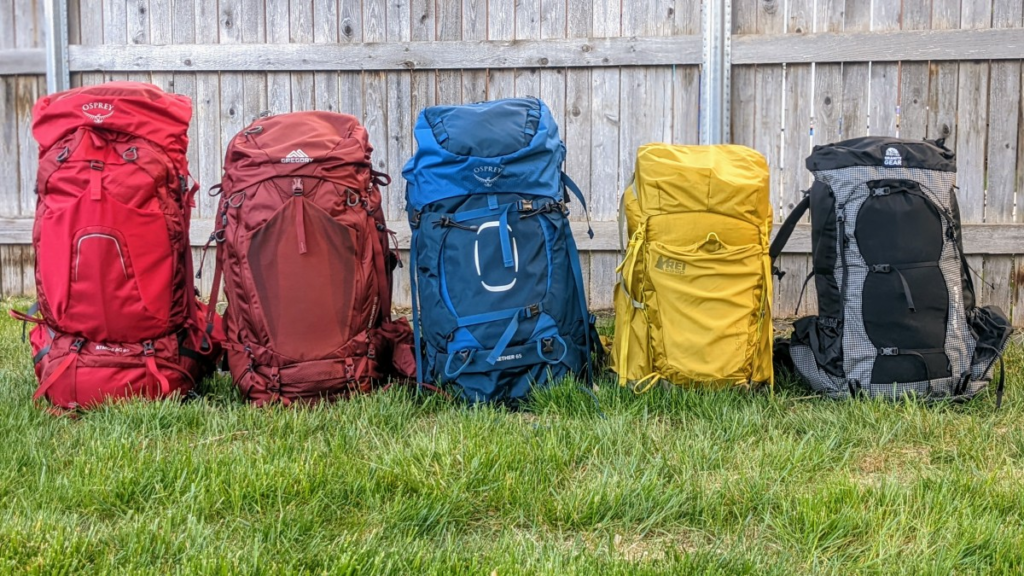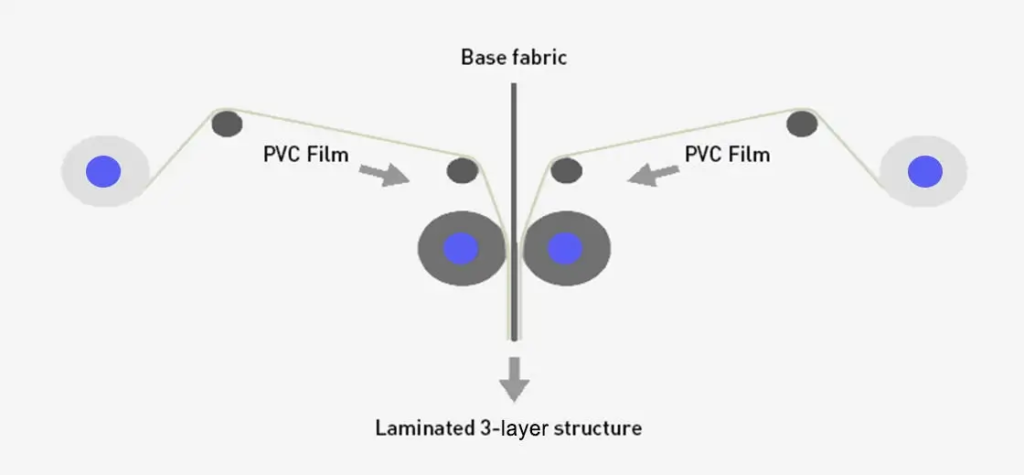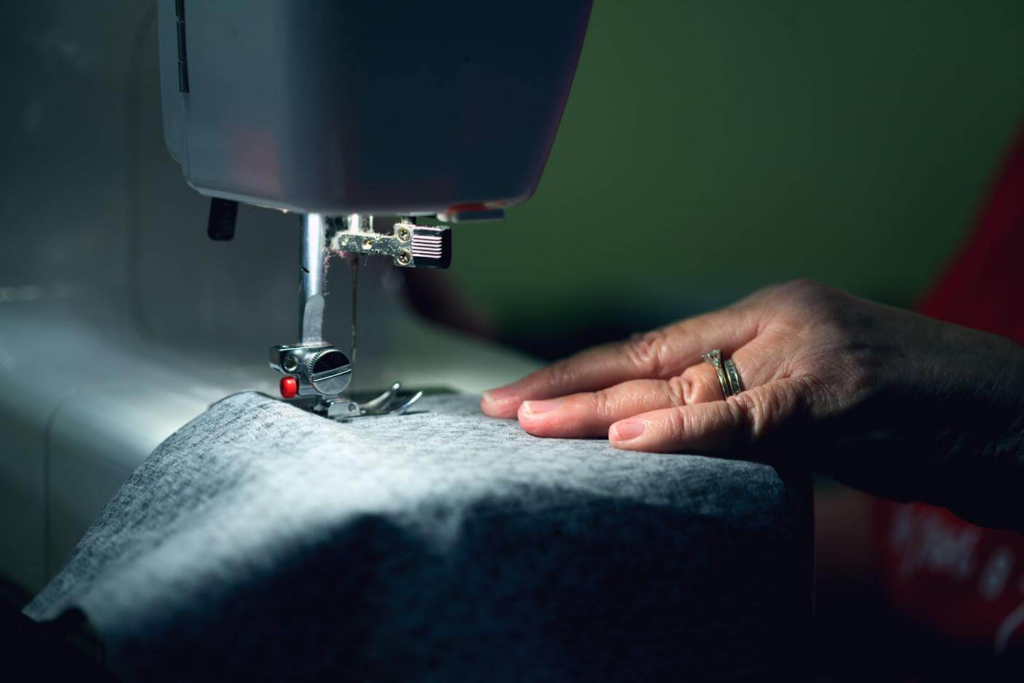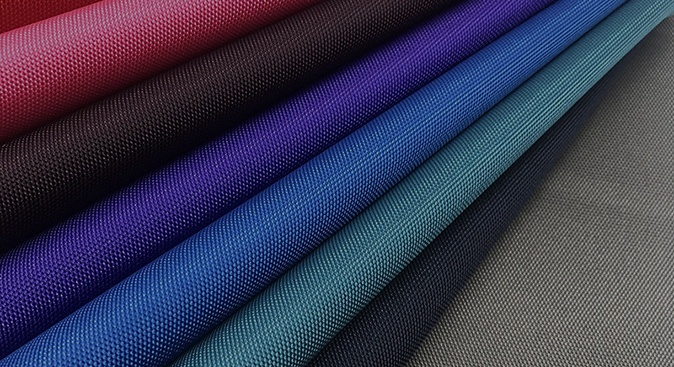PVC coated fabric is a versatile material used in a wide range of applications such as backpacks, luggage, tents, and many others. Its popularity is due to its durability, water resistance, and easy maintenance. PVC coated fabric is made by coating a base fabric with a layer of polyvinyl chloride (PVC) to provide added strength and protection.
There are different types of PVC coated fabric available in the market, each with unique features and properties. For instance, polyester PVC coated fabric is known for its high strength and tear resistance, making it ideal for heavy-duty applications. On the other hand, nylon PVC coated fabric is lightweight and offers excellent abrasion resistance, making it suitable for outdoor gear and backpacks.
Another type of PVC coated fabric is acrylic-coated polyester, which offers excellent UV resistance and is commonly used in awnings and outdoor furniture covers. Additionally, there is also a fire-retardant PVC coated fabric used in industrial applications where fire safety is a priority.
Overall, the different types of PVC coated fabric cater to specific needs and requirements, making it a popular choice in various industries.

Types of PVC Coated Fabric
Based on Base Fabric
Polyester PVC Coated Fabric
Polyester PVC coated fabric is a versatile and durable material that is widely used in the production of various outdoor gear and equipment, including backpacks, luggage, tents, and more. This type of fabric is made by coating a layer of polyvinyl chloride (PVC) onto a base fabric made of polyester fibers.
Features and Benefits
Durability: Polyester is a strong and durable synthetic material that can withstand wear and tear, making it ideal for use in products that will be subjected to daily use or harsh environments. This means that PVC-coated polyester materials will last longer and require less maintenance compared to other types of fabrics.
Water resistance: Polyester is naturally water-resistant, and when combined with a PVC coating, it becomes completely waterproof. This makes PVC-coated polyester materials ideal for outdoor products such as tents, backpacks, and luggage, as they will protect the contents from rain and moisture.
UV resistance: Polyester is also resistant to UV radiation, which can cause other types of fabrics to fade or weaken over time. This means that PVC-coated polyester materials will retain their color and strength even when exposed to sunlight for extended periods.
Lightweight: Polyester is a lightweight material, which makes it ideal for use in products that need to be carried or transported. PVC-coated polyester materials are also easy to pack and store, making them a popular choice for outdoor enthusiasts and travelers.
Cost-effective: Polyester is an affordable material compared to other synthetic fabrics, which makes PVC-coated polyester materials an excellent choice for manufacturers who want to keep production costs down while still offering high-quality products.
Common Applications
Polyester PVC coated fabric is widely used in the manufacturing of backpacks due to its durability, waterproofing, and strength. This fabric is commonly used for the production of backpacks designed for outdoor activities, such as hiking, camping, and mountaineering. It provides protection against rain and moisture, which is essential for keeping the contents of the backpack safe and dry. The fabric is also resistant to tearing and abrasion, making it ideal for rugged outdoor use. Additionally, the material is easy to clean and maintain, ensuring the backpack retains its appearance and functionality for longer periods of time.

Nylon PVC Coated Fabric
Nylon PVC-coated fabric is a durable and versatile material that is widely used in the production of backpacks, luggage, tents, and other outdoor gear. This fabric is made by coating a high-quality nylon substrate with a layer of PVC, which provides a water-resistant and abrasion-resistant surface.
Features and Benefits
Colorfastness: Nylon is highly resistant to fading and color transfer, which makes it an excellent choice for products that are exposed to sunlight. This ensures that products made from nylon maintain their original color and appearance for a longer period of time.
Versatility: Nylon can be used for a variety of products, including backpacks, luggage, tents, and even clothing. This makes it a versatile fabric that can be used in a variety of applications.
Easy to clean: Nylon is easy to clean and maintain. It can be easily wiped clean with a damp cloth or washed in a washing machine, which makes it ideal for products that are exposed to dirt or stains, such as backpacks or luggage.
Elasticity: Nylon has a high degree of elasticity, which makes it ideal for products that require stretch or flexibility, such as clothing or sportswear. This allows the fabric to move with the wearer and provide a comfortable fit.
Sustainability: Nylon can be made from recycled materials, which makes it a more sustainable option compared to other synthetic fabrics. It can also be recycled at the end of its life, reducing its impact on the environment.
Common Applications
Nylon PVC is commonly used in the production of luggage, tents, and other outdoor gear. Its versatility allows it to be used in a variety of settings, including hiking, camping, and traveling. The PVC coating provides an extra layer of protection, ensuring that the backpack or other gear remains dry even in wet conditions. With its many benefits, it’s no wonder why nylon PVC coated fabric is a top choice for manufacturers in the outdoor gear industry.

Cotton PVC Coated Fabric
Cotton PVC coated fabric is a unique and versatile material that combines the natural properties of cotton with the durability and waterproofing of PVC. The fabric is made by coating a high-quality cotton base with a layer of PVC, creating a strong and durable material that is ideal for a wide range of applications.
Features and Benefits of Using Cotton as the Base Fabric
Durability
One of the most significant advantages of using cotton as a base fabric is its durability. Cotton is a strong, long-lasting material that can withstand a lot of wear and tear. This makes it an ideal choice for products like backpacks, luggage, and tents, which are designed to withstand rough handling and exposure to the elements.
Long Lifespan
Thanks to its durability, cotton-based coated fabrics can last for years without showing signs of wear and tear. This means that consumers can rely on products made from these materials to last longer, reducing the need for frequent replacements.
Breathability
Another great feature of cotton is its breathability. Unlike synthetic materials, which can trap heat and moisture against the skin, cotton allows air to circulate freely. This makes cotton-based coated fabrics more comfortable to wear in hot or humid conditions, as they help to wick away moisture and keep the wearer cool.
Comfort
Thanks to their breathability, cotton-based coated fabrics are more comfortable to wear for extended periods. This makes them an ideal choice for products like backpacks, which may be worn for long hikes or outdoor adventures.
Sustainability
Finally, cotton is a more sustainable choice than many synthetic materials. Unlike synthetic fabrics, which are made from non-renewable resources like oil and gas, cotton is a natural and renewable resource. Additionally, cotton can be grown using sustainable farming practices, which help to minimize the environmental impact of production.
Eco-Friendly
By choosing cotton-based coated fabrics, manufacturers can reduce their environmental footprint and appeal to eco-conscious consumers. This can be a significant selling point for products like backpacks and tents, which are often marketed to outdoor enthusiasts who care about environmental sustainability.
Common Applications
Cotton PVC coated fabric is a popular material used in backpack manufacturing due to its durability, water resistance, and easy maintenance. The fabric is also versatile and can be used in a range of other outdoor applications such as tents, awnings, and protective covers. In addition to its practical uses, the fabric is also available in a variety of colors and patterns, making it a popular choice for designers who want to add a touch of style to their products. Whether you’re hiking through the mountains or exploring the city streets, cotton PVC coated fabric is a reliable and versatile choice for all your outdoor needs.

Based on Coating Type
Single-Coated PVC Fabric
Single-Coated PVC Fabric refers to a type of fabric that has a single layer of PVC (Polyvinyl Chloride) coating on one side. The PVC coating provides a number of benefits to the fabric, including increased durability, water resistance, and UV resistance. The fabric is commonly used in the production of outdoor gear, such as tents and awnings, as well as industrial applications, such as protective covers for equipment and machinery.
One of the unique features of Single-Coated PVC Fabric is its ability to be customized with different textures and colors, depending on the specific needs of the application. This versatility makes it a popular choice for manufacturers who need a durable and weather-resistant material that can also be aesthetically pleasing.
In addition, the single-coating process used to manufacture this fabric can be more cost-effective than other coating methods, such as double-coating or laminating. This can make Single-Coated PVC Fabric a more affordable option for manufacturers who need a high-quality, durable material for their products.
Coating Process and Properties
Coating Process
The coating process involves applying a layer of PVC resin onto a fabric substrate to create a waterproof barrier. The process begins by preparing the fabric substrate through processes such as cleaning, drying, and smoothing. The PVC resin is then mixed with additives such as plasticizers, stabilizers, and pigments to achieve the desired properties such as flexibility, color, and UV resistance.
The PVC resin mixture is then applied to the fabric substrate using various coating methods such as knife coating, roller coating, or spray coating. The coated fabric is then heated to allow the PVC resin to melt and bond with the fabric substrate. Finally, the coated fabric is cooled and inspected for quality before being rolled or cut into the desired size and shape.
Properties of Single-Coated PVC Fabric
Single-coated PVC fabric has several properties that make it suitable for use in outdoor gear and equipment. Firstly, it is waterproof, making it ideal for use in applications where protection from rain and moisture is crucial. Additionally, the PVC coating provides excellent resistance to abrasion, punctures, and tearing, making it durable and long-lasting.
Furthermore, single-coated PVC fabric has a high level of flexibility, allowing it to conform to different shapes and contours. This property makes it easy to work with during the manufacturing process, allowing for the creation of complex shapes and designs. The flexibility of the fabric also makes it easy to pack and store, as it can be rolled up or folded into a compact size.
Lastly, single-coated PVC fabric has good UV resistance, meaning it can withstand prolonged exposure to sunlight without degrading or losing its properties. This property makes it suitable for use in outdoor applications where prolonged exposure to the sun is expected.
Advantages and Disadvantages
Single-coated PVC fabric has several advantages and disadvantages for backpack manufacturing.
One advantage is its waterproof and durable nature, which makes it ideal for outdoor activities. It is also easy to clean and maintain. However, single-coated PVC fabric may not be the most environmentally friendly option as it is made from petroleum-based materials and is not biodegradable. It can also be heavy and stiff, making it less comfortable to wear for extended periods.
Additionally, single-coated PVC fabric may not be as breathable as other materials, which can lead to discomfort and moisture buildup. Therefore, when considering using single-coated PVC fabric for backpack manufacturing, it is important to weigh these pros and cons to determine if it is the right choice for your specific needs.

Double-Coated PVC Fabric
Double-coated PVC fabric is a specialized material that consists of a base fabric that is coated with PVC (polyvinyl chloride) on both sides. This process creates a highly durable and waterproof fabric that is ideal for a variety of outdoor applications.
The unique double-coated PVC construction provides an extra layer of protection against harsh weather conditions, making it an excellent choice for use in the manufacturing of tents, canopies, and other outdoor shelter products. Additionally, the fabric’s high resistance to abrasion and tear makes it perfect for use in the creation of heavy-duty bags, tarps, and covers.
One of the key benefits of double-coated PVC fabric is its versatility. It can be manufactured in a wide range of colors and patterns, allowing it to be used for both practical and aesthetic purposes. Furthermore, the material is easy to clean and maintain, making it an excellent choice for products that are frequently exposed to dirt, grime, and other outdoor elements.
In summary, double-coated PVC fabric is a specialized material that offers exceptional durability, waterproofing, and versatility. Its unique construction makes it ideal for a range of outdoor applications, including shelters, bags, tarps, and covers.
Coating Process and Properties
Coating Process:
Double-coated PVC fabric is created by applying a PVC coating to both sides of a woven fabric substrate. The coating is typically applied using a knife-over-roll process, which involves passing the fabric substrate over a knife-like device that spreads the PVC coating evenly over the surface. The coated fabric is then passed through a series of heated rollers to set the coating and ensure that it adheres firmly to the substrate.
Properties:
Double-coated PVC fabric boasts several unique properties that make it an ideal choice for outdoor gear:
Durability: The PVC coating adds an extra layer of strength to the fabric, making it highly resistant to tearing and abrasion. This durability makes it an excellent choice for outdoor gear that is subjected to harsh weather conditions.
Water Resistance: The PVC coating also provides excellent water resistance, making it a popular choice for tents, tarps, and other outdoor gear that needs to keep the elements out.
UV Resistance: The PVC coating also provides protection against harmful UV rays, which can cause fabrics to deteriorate over time. This UV resistance helps to extend the life of the fabric and ensure that it remains in good condition for many years.
Easy to Clean: Double-coated PVC fabric is easy to clean, making it an ideal choice for outdoor gear that is frequently exposed to dirt and grime. Simply wipe it down with a damp cloth, and it will be as good as new.
Advantages and Disadvantages
Double-coated PVC fabric is a popular choice for a wide range of applications due to its many advantages. One of the primary benefits is its durability, as the coating provides excellent resistance to water, abrasion, and UV rays. This makes it ideal for outdoor gear such as tents and tarps.
Another advantage of double-coated PVC fabric is its flexibility, which allows it to be easily molded and shaped to fit a variety of designs. It is also easy to clean and maintain, and can be quickly repaired if damaged.
However, there are some drawbacks to using this type of fabric. It can be heavier than other materials, which can be a concern for those looking to minimize weight for backpacking trips. It may also not be as breathable as other fabrics, which can lead to discomfort in hot and humid conditions.

Laminated PVC Fabric
Laminated PVC fabric is a specialized type of fabric that is commonly used in the manufacturing of various outdoor products such as tents, tarps, and covers. This fabric is made by laminating multiple layers of PVC (polyvinyl chloride) material onto a base fabric. The base fabric can be made of various materials such as nylon, polyester, or cotton, and provides the fabric with additional strength and durability.
The laminating process involves applying heat and pressure to the PVC layers and the base fabric, which results in the creation of a strong and waterproof barrier. This barrier protects the contents of the product from the elements, making it ideal for use in outdoor applications.
One of the unique features of laminated PVC fabric is its ability to be customized with a variety of colors and patterns. This makes it a popular choice for designers and manufacturers who want to create products with a specific look or branding.
In addition to its durability and customization options, laminated PVC fabric is also known for its ease of cleaning and maintenance. It can be easily wiped clean with a damp cloth or washed with mild soap and water.
Overall, laminated PVC fabric is a versatile and reliable material that has become a staple in the outdoor industry. Its combination of strength, durability, and customization options make it an excellent choice for a wide range of applications.

Coating Process and Properties
Laminated PVC fabric is a type of material commonly used in the production of backpacks, luggage, tents, and other outdoor gear. The manufacturing process of laminated PVC fabric involves coating a base material, such as nylon or polyester, with a layer of PVC (polyvinyl chloride) on one or both sides. This process is known as “coating.”
The coating process begins by preparing the base material, which is typically in the form of a roll of fabric. The material is cleaned and treated to improve its adhesion to the PVC coating. The PVC is then applied to the material using a variety of methods, including dipping, spraying, or roller coating.
Once the PVC is applied, the material is heated and cured to bond the PVC to the base material. This creates a strong, durable, and waterproof fabric that is resistant to abrasion, tearing, and UV radiation. The resulting fabric has a smooth, glossy appearance and a high level of tensile strength.
The properties of laminated PVC fabric make it ideal for use in a variety of outdoor applications. Its waterproof and abrasion-resistant properties make it suitable for use in backpacks, tents, and other gear that will be exposed to the elements. Its high tensile strength makes it ideal for use in applications that require a strong, durable material, such as luggage and protective gear.
In addition to its functional properties, laminated PVC fabric is also available in a wide range of colors and designs, making it a popular choice for fashion and decorative applications. It is a versatile and durable material that can be customized to meet the specific needs of different applications.
Advantages and Disadvantages
Laminated PVC fabric is a popular choice for backpack manufacturing due to its numerous advantages. Firstly, it is highly durable and resistant to water, making it ideal for outdoor use. Additionally, PVC fabric is easy to clean and maintain, which is important for long-term use.
However, there are also some disadvantages to using laminated PVC fabric for backpacks. One major drawback is that it is not biodegradable and can harm the environment if not properly disposed of. PVC fabric is also not breathable, which can cause discomfort for the user during extended use in warm weather.
Overall, while laminated PVC fabric has its advantages, it is important to consider its environmental impact and potential discomfort for the user when selecting materials for backpack manufacturing.

Factors to Consider when Choosing PVC Coated Fabric
Durability and Strength
This is a crucial factor to consider when choosing PVC coated fabric. The fabric should be strong enough to withstand the rigors of use, such as abrasion, tearing, and puncturing. In addition, the coating should be able to maintain its integrity over time, without cracking, peeling, or flaking.
Water Resistance and Waterproofing
PVC coated fabric should be highly resistant to water and moisture. It is essential to ensure that the fabric has adequate waterproofing to prevent water from penetrating the surface and damaging the contents inside.
UV Resistance and Colorfastness
When exposed to sunlight, PVC coated fabric can experience fading and discoloration over time. It is crucial to select a fabric that is UV-resistant and colorfast to ensure that the color remains vibrant and consistent over time.
Environmental Factors and Sustainability
The environmental impact of PVC coated fabric should be taken into consideration when making a choice. Look for fabrics that are produced with minimal environmental impact, such as those made from recycled materials or those that are biodegradable.
Cost and Availability
Finally, it is essential to consider the cost and availability of the PVC coated fabric. While it is important to choose a high-quality fabric, it is also important to ensure that it is available at a reasonable cost and in sufficient quantities to meet production needs.

Conclusion
PVC coated fabrics come in various types, each with its own unique features and benefits. One type is the 900D PVC coated fabric, which is widely used in the production of backpacks, luggage, and tents. This type of fabric is known for its durability and strength, making it perfect for rugged outdoor use.
The PVC coating provides a waterproof barrier, protecting the contents of the bag or tent from water damage. In addition, the coating makes the fabric resistant to mildew and other types of environmental damage.
The 900D PVC coated fabric is also resistant to tearing, abrasions, and punctures, which makes it ideal for heavy-duty applications. This type of fabric is also easy to clean and maintain, making it an excellent choice for outdoor enthusiasts who need a reliable and durable material.
The right PVC coated fabric is crucial for the manufacturing of high-quality backpacks, luggage, and tents. Choosing the appropriate fabric can significantly impact the durability, waterproofed, and overall performance of the final product. When selecting PVC coated fabric, it is essential to consider factors such as denier, weave, weight, and coating thickness. A careful selection process ensures that the fabric will withstand wear and tear, harsh weather conditions, and repeated use.



